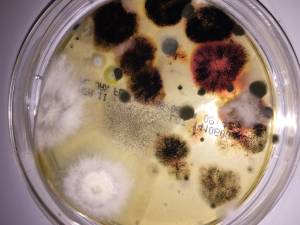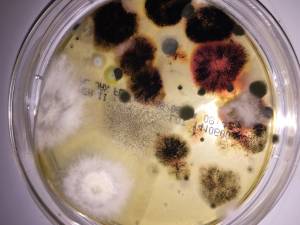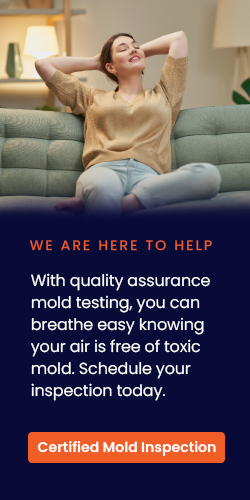
DIY Mold Petri Dish Taken from a Clean Environment
While it might be tempting to use DIY Mold Tests—petri dishes set out over a period of time to determine mold presence—to diagnose your household mold, these over-the-counter methods can be deceiving and inaccurate. The results lack enough credibility that lawyers, doctors, insurance companies, and remediation companies do not accept the results. Consumer Reports, in fact, rated four different brands of DIY mold tests “Not Recommended,” citing the following: “In some samples, the vials with media leaked over entire kit. In one, an unopened kit was moldy. No expiration dates on the kit; old media could affect the accuracy and reliability of the results. Label claims that kit can identify toxic mold, but the report the lab sends can’t tell you this. One unused plate came back positive for mold growth, indicating contamination at some point; not very reassuring for post remediation use.”
Let’s take a closer look at the problems associated with DIY mold test kits:
1) No Expiration Dates – DIY mold test kits sit on hardware shelves or storage areas for undisclosed amounts of time, subjecting the agar (gooey stuff) to contaminants. Because there is no readily identifiable expiration date for these kits, despite the requirement that they be sterile, consumers cannot determine how much potential handling or exposure these kits have had.
2) Demonstrated Lab Inaccuracies – There have been numerous cases where I’ve been told of “high mold” counts with a DIY kit when the actual levels are low and vice versa with “low mold” counts with DIY kit when the actual levels very high.
3) Uncontrollability of Shipping and Handling – DIY kits require being sent through the mail system for “lab analysis.” Such processing is unregulated, leaving the package susceptible to elements such as extreme temperatures and humidity, improper handling, and overall shipping lag time. Such factors can contribute to false positives and false negatives.
4) No Air Flow to Measure Mold in Cubic Units– Most standards and guidelines refer to mold spores per cubic meter or coliform forming unit but obtaining a level of mold per volume of air is impossible without a controlled airflow through the use of a mechanical pump.
5) No Control Sample – A control sample is necessary to validate the elevation of spores and provide a meaningful reference point, but many DIY kits do not offer a dish to take such a comparison sample from another room or outside.
6) Misleading Marketing – Consumers often think that the DIY kit they purchase will quantify and qualify they types of molds they have, but this is not the case. For an additional costs, the petri dishes must be sent out to the lab for analysis (see point 1, 2, 3 for why this is meaningless).
7) No Accredited Laboratory Certification, Endorsement or Chair of Custody – The labs associated with DIY kits are rarely certified (those listed with AIHA-LAP LLC Accredited Labs) and are not endorsed by any accredited agency. Often there is no chain of custody (COC) to properly document the transfer of the kit or to note acceptance of the kit by the lab and critical data such as the date, time of analysis, lab location etc.…are often omitted.
8) Kits Do Not Account for Dead Spores: Settling plates and other DIY kits are focused on growing mold, but dead spores can also impact your health. Water damage-makers such as Stachybotys, Chaetomium and Ulocladium may not show up on the DIY kit.
9) No Inspection – DIY kits do not provide an overall understanding of your mold contamination. A critical part of a comprehensive mold investigation is the inspection process, which requires specialized instrumentation such as digital moisture meters, hygrometers, infrared cameras and other tools along with an expert visual observation.
10) Spore Characteristics Make Some More Likely to “Stick” – Mold spores have unique weight, density and air flow characteristics and do not settle at the same rate. Heavier spores, for example, settle on the petri dishes at a quicker rate and take up more of the sample plate. Sticky molds, especially water damage indicators and Black Mold, might not appear as readily on the DIY kits, but this absence could indicate greater growth elsewhere.
All homes will contain some level of spore activity when air samples are collected because mold is a common part of the environment. DIY kits, then, are essentially useless for diagnosing the complexity of your airborne mold contamination and should be handled by professionals. The EPA agrees: “Sampling for mold should be conducted by professionals who have specific experience in designing mold sampling protocols, sampling methods, and interpreting results. Sample analysis should follow analytical methods recommended by…professional organizations.”
While DIY tests can be used for entertainment value, much like a Chia Pet, true mold concerns should be handled by companies that understand the diagnostic process necessary to qualify and quantify potentially hazardous mold growth.






